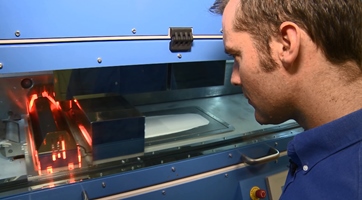 |
| October 06, 2015 | Volume 11 Issue 37 |
Designfax weekly eMagazine
Archives
Partners
Manufacturing Center
Product Spotlight
Modern Applications News
Metalworking Ideas For
Today's Job Shops
Tooling and Production
Strategies for large
metalworking plants
High-speed 3D printing aims to take on injection molding

The new high-speed AM machine will enable serious production of volumes over one million, which is currently inconceivable for 3D printing.
The world's first additive manufacturing (3D-printing) machine that can make plastic parts as fast and as cheaply as traditional manufacturing is being built by the University of Sheffield in the U.K.
The machine will build parts up to three times larger and 100 times faster than current comparable additive manufacturing (AM) machines, making it capable of challenging conventional injection molding for high-volume production.
The £1 million (~$1.5 million) project -- funded by the Engineering and Physical Sciences Research Council (EPSRC) -- has the potential to transform both manufacturing and distribution. Low-cost, high-volume additive manufacturing would enable parts to be made where they are needed, rather than produced centrally.
Professor Neil Hopkinson from the University of Sheffield's Faculty of Engineering says, "Additive manufacturing is already being used to make tens of thousands of a product -- such as iPhone covers -- and ten years ago that volume was unthinkable. This machine will enable serious production of volumes over one million, which is currently inconceivable. I believe history will repeat itself and in ten years' time, producing volumes over a million using additive manufacturing will be commonplace."
The process, called high-speed sintering (HSS), selectively fuses polymer powder layer by layer, similar to other AM processes. However, instead of using lasers, HSS prints infra-red-absorbing ink onto a powder bed. Once a layer has been printed, it is exposed to infra-red light, which heats the powder covered by the ink, causing it to fuse, while the rest of the powder remains cool.
The machine is based on a technology developed by Professor Hopkinson, who originally filed patents on the process as lead inventor at Loughborough University. The technology for HSS is being licensed to industrial machine manufacturers on a non-exclusive basis, with new machines being expected on the market from 2017/18.
The new machine will be able to make parts up to 1 m3 -- the size of a washing machine -- which is three times bigger than existing machines. The speed will depend on the size of the product, but the team estimates that small components will be built at a rate of less than one second per part, allowing AM to compete with injection molding for high-volume manufacturing.
AM has advantages over injection molding, which makes the process more attractive. As Professor Hopkinson explains, "With additive manufacturing you can make more complex parts and make each part unique," he says. "You can also make the parts where they are needed, which reduces transport costs. Additive manufacture also limits the risks involved. With injection molding, you have to make tools, which is expensive and has to be done in advance. With AM, you miss out on that stage, moving straight from design to manufacture."
The machine will initially be built in the University of Sheffield's Advanced Manufacturing Research Centre (AMRC) before installation in the University's Centre for Advanced Additive Manufacturing (AdAM), of which Professor Hopkinson is director.
Dr. Andy Bell, from the AMRC's Design Prototype and Test Centre (DPTC), says, "This machine will be built completely from scratch, drawing on all the skills and expertise of our design engineers. We have been involved in developing machines with commercial partners in the past, but this will be the biggest machine we have ever created."
Source: University of Sheffield (U.K.)
Published October 2015
Rate this article
View our terms of use and privacy policy
